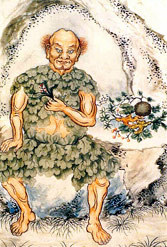pangu
A
recurrent theme in Chinese medicine is that the body and its
physiology are a microcosm of the universe and its movements.
In what amounts to a reversal of these images, the body of Pangu,
the cosmic giant who holds heaven and earth apart in the Chinese
creation myth, literally transforms into the features of the
universe:
"His
breath became the wind and clouds; his voice became the thunder.
His left eye became the sun; his right eye became the moon.
His four limbs and five extremities became the four cardinal
points and the five sacred mountains. His blood and semen became
the water and rivers. His muscles and veins became the earth's
arteries; his flesh became fields and land. The hair on his
head and his beard became the stars, the hair on his body became
the plants and trees. His teeth and bones became metal and rock;
his vital marrow became pearls and jade. His sweat and bodily
fluids became streaming rain. All the mites on his body were
touched by the wind and were turned into the black-haired people
[= the Chinese]."

An
18th Century depiction of Pangu. He is often shown clothed in
leaves; sometimes he also has horns on his head and holds the
sun and moon.
From China:
The Land of the Heavenly Dragon edited by Professor Edward
L. Shaughnessy
|